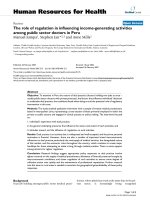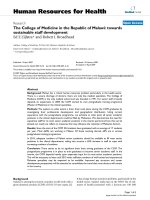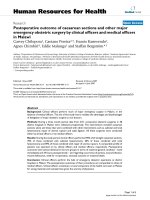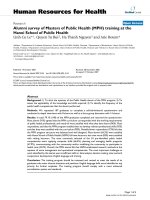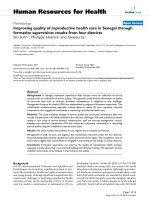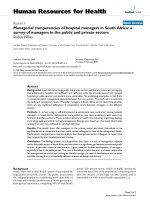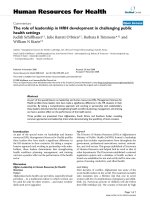Báo cáo sinh học: " Raman enhancement of rhodamine adsorbed on Ag nanoparticles self-assembled into nanowire-like arrays" docx
Bạn đang xem bản rút gọn của tài liệu. Xem và tải ngay bản đầy đủ của tài liệu tại đây (2.52 MB, 22 trang )
This Provisional PDF corresponds to the article as it appeared upon acceptance. Fully formatted
PDF and full text (HTML) versions will be made available soon.
Raman enhancement of rhodamine adsorbed on Ag nanoparticles
self-assembled into nanowire-like arrays
Nanoscale Research Letters 2011, 6:629 doi:10.1186/1556-276X-6-629
Marianthi Panagopoulou ()
Nikolaos Pantiskos ()
Panos Photopoulos ()
Jun Tang ()
Dimitris Tsoukalas ()
Yannis S Raptis ()
ISSN 1556-276X
Article type Nano Express
Submission date 24 June 2011
Acceptance date 14 December 2011
Publication date 14 December 2011
Article URL />This peer-reviewed article was published immediately upon acceptance. It can be downloaded,
printed and distributed freely for any purposes (see copyright notice below).
Articles in Nanoscale Research Letters are listed in PubMed and archived at PubMed Central.
For information about publishing your research in Nanoscale Research Letters go to
/>For information about other SpringerOpen publications go to
Nanoscale Research Letters
© 2011 Panagopoulou et al. ; licensee Springer.
This is an open access article distributed under the terms of the Creative Commons Attribution License ( />which permits unrestricted use, distribution, and reproduction in any medium, provided the original work is properly cited.
1
Raman enhancement of rhodamine adsorbed on Ag
nanoparticles self-assembled into nanowire-like arrays
Marianthi Panagopoulou
1
, Nikolaos Pantiskos
1
, Panos Photopoulos
2
, Jun Tang
3
, Dimitris
Tsoukalas
1,4
and Yannis S Raptis*
1
1
Physics Department, School of Applied Mathematical and Physical Sciences, National
Technical University of Athens, Zografou Campus, Zografou, Athens 157 80, Greece
2
Department of Electronics, Technological Educational Institute of Athens, 12210
Aegaleo, Greece
3
North University of China, Taiyuan, Shanxi, People's Republic of China
4
Institute of Microelectronics, NCSR “Demokritos”, GR 15310 Ag. Paraskevi Greece
*Corresponding author:
Email addresses:
MP:
NP:
PP:
JT:
DT:
YSR:
Abstract
This work reports on Raman scattering of rhodamine (R6G) molecules absorbed on either
randomly distributed or grating-like arrays of approximately 8-nm Ag nanoparticles
developed by inert gas aggregation. Optimal growth and surface-enhanced Raman
scattering (SERS) parameters have been obtained for the randomly distributed
nanoparticles, while effects related to the aging of the silver nanoparticles were studied.
Grating-like arrays of nanoparticles have been fabricated using line arrays templates
formed either by fracture-induced structuring or by standard lithographic techniques.
Grating structures fabricated by both methods exhibit an enhancement of the SERS
signal, in comparison to the corresponding signal from randomly distributed Ag
nanoparticles, as well as a preferential enhancement in the areas of the sharp features, and
a dependence on the polarization direction of the incident exciting laser beam, with
respect to the orientation of the gratings structuring. The observed spectroscopic features
are consistent with a line-arrangement of hot-spots due to the self- alignment of metallic
nanoparticles, induced by the grating-like templates.
Keywords: SERS; self-aligned silver nanoparticles; R6G; Raman spectra;
nanotechnology (design-applications).
Introduction
2
The effect of the surface-enhanced Raman scattering (SERS) has been observed, since
1974, in (organic) molecules being in close contact with properly structured metallic
surfaces, especially nanosized metallic particles. According to this effect, an
enhancement, by many orders of magnitude, of the Raman signal from organic molecules
was observed, when these molecules were attached to metallic (usually Ag, Au, but also
Ni, Co, etc) nanoparticles. An intensive research activity has been carried out, in the
following decade, concerning the mechanisms which are responsible for the strong
enhancement of the scattering intensity, with respect to the signal of the conventional
Raman scattering, with two models, namely, the electromagnetic enhancement and the
electrochemical enhancement, proposed as the dominant ones (for a review of the related
activities in the decade 1974 to 1984, see [1, 2]; see also [3].
Taking into account that in the SERS effect, in addition to the active molecule, which is
the actual scattering center (e.g., pyridine, rhodamine, etc.), the most important role is
played by the characteristics of the metallic surface, i.e. the metal itself (with prevailing,
Ag and Au), and the nanostructure of the metallic surface (several geometries, with
typical sizes from several nanometers up to a few tens of nanometers); the corresponding
interest has been revitalized the last decade (2000 to 2010), due to the fast development
of the nanotechnology and the related structures and devices. The shape and the
dimensions of the metallic nanoparticles are strongly affecting the intensity enhancement,
since those parameters have an important influence in the spectrum of the surface
plasmons [4], while especially interesting are the two-dimensional arrays of nanopillars
or nanowires, where SERS effect could be observed even for metals, such as Ni and Co,
which were not considered as effective SERS-active [5] materials. According to
theoretical studies, the characteristics of the plasmon resonances are correlated with the
cross-section of the nanowires [6], with obvious selective scattering applications in the
nanosystems [7]. The arrangement of the nanowires in periodic arrays (as a result of
either a self- or an induced organization) exhibits related polarization characteristics in
the SERS effect [8], quite similar to polarization effects obtained through random parallel
nanostructures in gold thin films [9].
The research in this field has been revived during the last years, from both aspects of
view, the basic physics (plasmonic properties of random and periodic metallic
nanostructures) and chemistry, as well as the potential of new technological tools in the
area of chemical sensors. This generation of sensors, which is based on plasmonic
excitation effects, is very promising in the fields of chemistry, biochemistry, and
biomedical research.
Experimental details
Two sets of SERS-active samples are studied by microscopic and spectroscopic
techniques. The first set, consisting of randomly distributed Ag nanoparticles, is used to
obtain the optimal growth and SERS parameters. It is also used to check the influence, to
the SERS efficiency, of the different substrates and of the time elapsed since the dying of
the nanoparticles. The second set consists of silver nanoparticles evaporated over grating-
like structured surfaces. Self-alignment effects of the nanoparticles, due to the structure
of the surfaces, are monitored by scanning electron microscopy (SEM) and atomic force
3
microscopy (AFM) techniques, while its influence on the Raman enhancement is studied
by micro-Raman scanning and polarization-dependent SERS measurements.
Growth: preparation
Silver nanoparticles, with typical sizes of 8 to 18 nm, were deposited through an inert gas
aggregation method [10], in different substrates, like Si, SiO
2
, quartz, and epoxy resin.
AFM images of the randomly distributed Ag nanoparticles are shown in an additional file
[see Additional file 1]. Grating-like arrays of nanoparticles have been fabricated by
depositing Ag nanoparticles on substrates properly configured before the deposition,
either by standard lithographic techniques, or by a technique based on fracture-induced
structuring [11] (FIS). The gratings prepared by the FIS method were made on silicon and
quartz substrates. For this approach, AZ5214 type of photoresist was used, spin coated at
5,000 to 7,000 rpm, and baked at 60°C for 30 to 40 min, under continuous pressure
between the two similar substrates, to assure better adhesion. Sudden detachment of the
two substrates results in the spontaneous formation of the fracture-induced patterning,
which is used in the next step, as the substrate for the AgNP deposition. Using AFM and
FESEM it is demonstrated that the Ag nanoparticles are preferentially deposited at the
peaks of the lines forming self-assembled nanowires [12]. Representative AFM images
illustrating the nanowire formation on the peaks are shown in figure 1. FIS method is
very simple to apply but it suffers from wafer-scale manufacturability. For that reason,
we also propose and demonstrate the preparation of triangular cross-section gratings at
wafer scale made using conventional processing. The lithographically prepared gratings
were constructed on Si substrate following a wet thermal oxidation that resulted to the
formation of 1 µm oxide. Then optical lithography and 0.5-µm wet etching in diluted HF
were used to create parallel oxide trenches of triangular cross-section. In an additional
file [see Additional file 2] we show the process sequence developed to form these oxide
arrays as demonstrated by AFM measurements shown in Figure 2. In Figure 3, we show
AFM measurements of the same gratings after nanoparticle deposition, where a small
peak is shown on top of the triangular structure.
Concerning the arrangement of the nanoparticles in lithographically formed stripe
templates, it is shown [12] that they are preferentially aligned along the edge lines of the
stripes, through an electrostatic self-assembling. A SEM image of this edge-driven
preferential alignment is presented in Figure 4.The silver nanoparticles, accumulated on
top of the grating-like structures, are preferentially aligned in such a way as to have much
more contact-points along, rather than perpendicular, to the axis of the structure. Due to
this arrangement, we have a denser concentration of hot-spot points (confirmed by the
stronger enhancement of the SERS signal from these structures, as well as by the
mapping across the structure), with a preferential orientation of them along the axis of the
structure (confirmed by the polarization measurements of the SERS signal); both
confirmations are presented in the next paragraph. This configuration of the predominant
hot-spot orientation is similar to a nanowire structure.
Spectroscopy
The study of the silver nanoparticle systems, by SERS spectroscopy, was carried out in
macro- and micro-Raman configurations. The samples to be characterized by SERS
4
spectroscopy were immersed, for 12 h, in methanol (or water) solution of rhodamine
(R6G), with molarities of the order of magnitude of 10
−
4 M, and then dried by free
evaporation of the solvent, for a few minutes. The Raman measurements were taken in
ambient conditions. We have tried different wavelengths and have obtained optimum
SERS spectra with the 514.5-nm Ar
+
laser line. For the macro-Raman measurements, a
SPEX 1403 double monochromator with standard photon-counting system was used. For
this series of measurements, we have used 20-mW excitation beam power, focused by 75-
mm focal-length lens, either cylindrical or spherical, depending on the specific
measurements. In this series of measurements, a fluctuation of the SERS intensity was
observed, immediately after illumination with the laser beam. All the measurements were
taken after a stabilization interval of half an hour after illumination, in order to overcome
this effect, known as photobleaching. For the micro-Raman measurements, a JY T64000
triple monochromator, with optical microscope of magnification up to ×100, and a liquid
nitrogen-cooled CCD detector was used, equipped with motorized stepping drive motors
for the scanning of the grating-like structures. For this series of measurements, an
excitation beam power of 0.01 to 0.05 mW, was used, in order to minimize heating and
photobleaching effects.
Results and discussion
Randomly distributed Ag nanoparticles
Randomly distributed Ag nanoparticles were studied as a function of deposition time, in
order to obtain the optimum evaporation condition, concerning the maximization of the
enhancement factor. In Figure 5, the SERS spectra for different nanoparticle deposition
times are shown. The SERS R6G spectra exhibit the enhancement of the 612 cm
−1
mode,
which is characteristic of the silver-nanoparticle-mediated SERS, in contrary to other
cases like the gold-nanoparticle-decorated InP nanowires [13] where the enhancement is
manifested by the high frequency part (1,300 to 1,700 cm
−1
).
An increasing SERS signal is observed with increasing deposition time, tending however
to a saturation level, as it is shown in Figure 6. This dependence is attributed to the
increasing surface density of the Ag nanoparticles, in the initial stage. At a deposition
time of 20 to 30 min, the substrate surface becomes fully covered, and any further
increase of the deposition time does not increase any more the number of the surface
nanoparticles on which SERS-active (R6G) molecules can be anchored. Moreover, it
results in the formation of nanoparticle aggregations in larger size clusters, which act as
less-efficient SERS-mediating particles (due to lower curvature), leading to a saturation
of the enhancement.
The exposure to the atmosphere of the Ag nanoparticles, immersed in R6G-solution,
incites a gradual degradation of the SERS effect. This degradation is more intense when
the exposure to the atmosphere is combined with the illumination of the sample by the
excitation laser beam. These aging effects are shown in Figure 7, where freshly prepared
samples are compared with samples after 1 week in ambient conditions and in a
desiccator. Such effects of silver tarnishing, by time, are also known in the literature.
More detailed work is in progress, in order to systematically test the influence of the
5
parameters like the duration and the environment of exposure, as well as the illumination
of the samples under vacuum, for the SERS measurements. In addition, preliminary
attempts related to the protective covering of the Ag nanoparticles with a passivation
silicon oxide layer have faced the problem of a diminishing SERS signal because,
probably, of the weak coupling of R6G molecules with the surface plasmon excitations of
the AgNPs, due to the passivation layer. Therefore, all the consequent measurements
were carried out following the same procedure, in order to minimize the aging-related
fluctuations in the SERS intensity.
Periodic arrays
Periodic arrays of Ag nanoparticles arranged in parallel lines, were studied by SERS
techniques. Using different fabrication methods (lithographic or FIS) and different
substrates (Si or quartz), we were able to compare the SERS efficiency from the
corresponding combinations. Two types of SERS (R6G) measurements were carried out
in the structured nanoparticles. With macro-Raman measurements, we were able to
compare the average behavior of differently structured and non-structured areas (and
even nanoparticle-free substrates). In order to show clearly the further increase of the
SERS (R6G) signal, observed in the case of AgNPs evaporated over structured substrate,
the comparison of the SERS intensities is carried out regarding samples with low
evaporation times (i.e., 2 to 4 min) for the silver nanoparticles, since these evaporation
times correspond to the lower SERS-detection limit, in the case of the unstructured
substrates. For this measurements, a cylindrical lens (focal length of 75 mm) was used,
with an elliptical spot size of typical semi-axis dimensions 1,000 × 25 µm, resulting in a
sampling area of ≈80 × 10
3
µm
2
= 0.08 mm
2
. The increase of the SERS signal, on the
structured nanoparticles areas, is manifested more clearly in samples with low deposition
time (e.g., 2 min) like the ones shown in Figure 8, where the FIS-patterned nanoparticles
(spectrum 3) present an enormous enhancement with respect to the nanoparticles over
lithographic stripes (spectrum 2),
FIS
Lith
10
I
I
≈
, and, especially, to the randomly
distributed nanoparticles over silicon (spectrum 1),
2
FIS
Random
10
I
I
≈
(the dashed lines
are indicative of the photoluminescence background of R6G). These factors have to be
considered as further amplification of the enhancement coefficient, obtained in the case
of the randomly distributed AgNPs, which varies by two orders of magnitude, depending
on the deposition time (see Figures 5 and 6), estimated, by independent measurements, to
be of the order of 10
4
, at least.
In the same macro-Raman configuration, polarization measurements have been carried
out. The polarization of the excitation and the scattered light were kept constant, in an
exact back scattering geometry (in order to eliminate Brewster angle effects, for the
incident radiation, and polarization dependence of the spectrometer efficiency, for the
scattered radiation), while the sample was in a goniometric table rotating about the
incident-scattering axis. A spherical lens of the same focal length (75 mm) was used,
instead of the cylindrical one, in order to minimize effects related to the percentage
6
change of the structured area within the illuminated-sampling area, during the sample
rotation. The polarization dependence of the scattered light is shown in Figure 9, where a
square-sine curve is also presented to assist the eye. The intensity variation exhibits a
maximum when the polarization is parallel to the axis of the aligned nanoparticles, (0°
and 180°, in Figure 9), and a minimum when it is perpendicular to these lines (90°). The
deviation of the 90° point, of Figure 9, from the minimum value is due to statistical
reasons. The specific data points correspond to macro-Raman measurement, with a
rotating goniometric stage (for reasons described above). It is very probable, therefore,
during the rotation of the sample to excite region of the grating-like structures with
slightly different nanoparticle density or rhodamine concentration. The overall
dependence is in accordance with the literature where, in similar systems, it is found that
the SERS signal is stronger when the excitation polarization is perpendicular to the
interface between nanocubes and nanowires [14], or parallel to the axis of nanoparticle
pairs [15]. Concerning our system, these observations can be explained by a hot-spot
model. According to this model, when a rhodamine molecule lies between two close
laying AgNPs, the electromagnetic mechanism of enhancement is expected to contribute
stronger when the excitation polarization is parallel to the axis connecting the centers of
the two metallic nanoparticles, due to the enhancement of the electromagnetic field,
between the adjoining nanoparticles.
Finally, the grating-like structured nanoparticles were examined by micro-Raman
technique. Samples of several grating-periodicities and deposition times have been
measured. The samples were scanned perpendicularly to the grating lines with different
scanning steps (depending on the periodicity of each structure) and a spatial resolution of
approximately 1 µm. During the scanning, a spectral range of 500 to 900 cm
−1
was
recorded, and the intensity of two characteristic Rhodamine peaks (612 and 774 cm
−1
) is
monitored. In Figure 10, the intensity of those two peaks is plotted as a function of the
position, for three samples of different structural characteristics but with the same
deposition time, of 4 min, for the silver nanoparticles. Two of them are fabricated by the
FIS method in different substrates (quartz and Si), while the third one is made on Si, by
lithographic method. The intensity variation exhibits a, more or less, clear periodicity
similar to the periodicity of the structure, which is indicated by the T values; (see the inset
labels of Figure 10). It is worth to note that the absolute SERS signal, as far as it concerns
the FIS samples, is by one order of magnitude stronger in the case of low pattern
periodicity (i.e., 5 µm), in comparison to the absolute signal of a doubled periodicity
(11 µm). The maxima are unambiguously, located in the peaks of the grating structures,
as it is visually confirmed through the microscope of the micro-Raman system. In the
case of the higher periodicity (
≥
10 µm), a more clearly defined depth of modulation, as a
function of the position, is observed, because, (with such a periodicity), we have enough
spatial resolution (through of the approximately 1-µm-spot size of the micro-Raman
detection), to clearly reveal the further enhancement of the SERS signal induced by the
edge-driven alignment of the nanoparticles accumulated on the peaks of the grating
structures. However, the stronger enhancement observed in low periodicities might be of
importance from the applications point of view.
.
Conclusions
7
In conclusion, we have presented SERS-based investigation on randomly distributed and
periodically self-arranged metallic nanoparticles. Optimization parameters obtained
through the randomly distributed NPs, were taken into account in the study of the
periodic structures. These studies confirm, through polarization measurements and micro-
Raman scanning, the signal enhancement from the nanoparticles which are aligned in a
form of nanowires, and prove that the synergetic combination of the two spontaneous
organization processes (FIS patterning and nanoparticle self-alignment) can lead to
further SERS enhancement with physically interesting aspects and potentially promising
technological consequences.
Competing interests
The authors declare that they have no competing interests
Authors' contributions
MP has prepared the FIS and lithographic substrates for Ag-NPs deposition, collected and
analyzed the SERS data on periodic structures. NP has participated in the randomly
distributed Ag-NPs deposition, SERS acquisition and analysis. PP has participated in the
design and realization of the Ag-NPs deposition for all the sample sequences. JT has
participated in the acquisition and analysis of the AFM images of the Ag-NPs on the
periodic structures. DT has participated in the conception and design of the different
sequences of the structured substrates and Ag-NPs deposition. YSR has participated in
the conception, design and realization of the SERS measurements of random and
structured substrates. DT and YSR conceived and designed the study. All authors have
been involved in drafting and revising the manuscript and have given the final approval
of the version to be published.
Acknowledgments
Kind help by Dr. A.G. Kontos and M C. Skoulikidou for the AFM-SEM imaging is
acknowledged with appreciation. We acknowledge financial support from Nanosource
Marie-Curie project funded by EU.
References
[1] Otto A: Surface-Enhanced Raman Scattering: “Classical” and
“Chemical” Origins. In Light Scattering in solids IV: topics in applied physics.
Chapter 6. Edited by M. Cardona, G. Guntherodt. New York: Springer;
1984:289–418
[2] Arya K, Zeyher R: Theory of Surface-Enhanced Raman Scattering. In
Light Scattering in solids IV: topics in applied physics. Chapter 6. Edited by M.
Cardona, G. Guntherodt. New York: Springer; 1984:419–462
[3] Moskovits M: Surface-enhanced spectroscopy. Rev Mod Phys 1985,
57:783
[4] Mock JJ, Barbic M, Smith DR, Schultz DA, Schultz S: Shape effects in
plasmon resonance of individual colloidal silver nanoparticles. J Chem Phys
2002, 116:6755
8
[5] Yao JL, Pan GP, Xue KH, Wu DY, Ren B, Sun DM, Tang J, Xu X, Tian
ZQ: A complementary study of surface-enhanced Raman scattering and
metal nanorod arrays. Pure Appl Chem 2000, 72:221
[6] Kottmann JP, Martin OJF, Smith DR, Schultz S: Non-regularly shaped
plasmon resonant nanoparticle as localized light source for near-field
microscopy. Phys Rev B 2001, 64:235402
[7] Tao A, Kim F, Hess C, Goldberger J, He R, Sun Y, Xia Y, Yang P:
Langmuir-Blodgett silver nanowire monolayers for molecular sensing using
surface-enhanced Raman spectroscopy. Nano Letters 2003, 3:1229
[8] Jeong DH, Zhang YX, Moskovits M: Polarization-Dependent Surface-
Enhanced Raman Scattering from a Silver-Nanoparticle-Decorated Single
Silver Nanowire. J Phys Chem B 2004, 108:12724
[9] Brolo AG, Arctander E, Addison CJ: Strong Polarized Enhanced-
Raman Scattering via Optical Tunneling through Random Parallel
Nanostructures in Au Thin Films. J Phys Chem B 2005, 109:401.
[10] Tang J, Verrelli E, Tsoukalas D: Assembly of charged nanoparticles
using self-electrodynamic focusing. Nanotechnology 2009, 20:36 365605.
[11] Pease LF, Deshpande P, Wang Y, Russel WB, Chou SY: Self-formation
of sub-60-nm half-pitch gratings with large areas through fracturing. Nature
Nanotechnology 2007, 2:545–548.
[12] Tang J, Verrelli E, Giannakopoulos K, Tsoukalas D: Electrostatic self-
assembly of nanoparticles into ordered nanowire arrays. J Mater Res 2011,
26:209–214.
[13] Chen J, Mårtensson T, Dick KA, Deppert K, Xu HQ, Samuelson L, Xu H:
Surface-enhanced Raman scattering of rhodamine 6G on gold nanoparticles
deposited 3-dimensionally on nanowire arrays. Nanotechnology 2008,
19:275712
[14] Camargo PHC, Cobley CM, Rycenga M, Xia Y: Measuring the SERS
enhancement factors of hot spots formed between an individual Ag nanowire
and a single Ag nanocube. Nanotechnology 2009, 20:434020.
[15] Theiss J, Pavaskar P, Echternach PM, Muller RE, Cronin SB: Plasmonic
nanoparticle arrays with nanometer separation for high-performance SERS
substrates. Nano Letters 2010, 10:2749.
9
Figure 1. AFM top view and cross-section profile of the structures fabricated by the
FIS method. Nanoparticle deposition, results in nanoparticle accumulation, shown by the
small peak at the top of the structures, (pointing-arrows).
Figure 2. AFM images of the oxide arrays fabricated by optical lithography and wet
etching. (a) Oblique view. (b) Top view and cross-section profile (along the black trace)
before the nanoparticle deposition.
Figure 3. AFM top view and cross-section profile (along the black line), of the
lithographically prepared structure. (After nanoparticle deposition) A small peak
indicated by the pointing-arrows, is observed at the top of the structure due to self-
assembled NPs.
Figure 4. SEM image. The edge-driven preferential alignment of silver nanoparticles on
the edges of lithographically prepared stripes. Scale-length: 2 µm, (200 nm, in the inset).
Figure 5. R6G-SERS spectra from randomly distributed AgNPs, for several
deposition times.
Figure 6. Deposition-time dependence of SERS intensity from randomly distributed
AgNPs, (after subtraction of luminescence background).
Figure 7. R6G-SERS spectra, from randomly distributed AgNPs, showing aging
effects, and dependence on the storing environment.
Figure 8. SERS from different structures, and a comparison of the corresponding
scattering intensities. Above the R6G luminescent background.
Figure 9. Polarization dependence of SERS signal, from grating-like structure.
Angle is measured with respect to the axis of the gratings, along which the nanoparticles
are preferentially aligned, see text.
Figure 10. Micro-Raman scanning of AgNP-decorated grating-like structures.
Showing a spatial modulation of the SERS intensity with the periodicity of the structures.
Fabrication parameters are given in the figure insets, while the AgNP deposition time is
4 min for all the structures. Zero value of the horizontal “x position” scale corresponds
(within the approximately 1-µm resolution of the micro-Raman system) to the peaks of
the grating structures.
10
Additional files
Additional file 1
Title: AFM image of randomly distributed silver nanoparticles
Description: We have initially studied the deposition conditions to obtain controlled
density and size distributions of the nanoparticles. Using Transmission Electron
Microscopy (TEM), we have found that by changing the deposition conditions like
substrate temperature, deposition time, and DC power, we can control the surface density
of the nanoparticles as well as their nominal size which are up to 1,012 cm
−2
and 2 to
14 nm, respectively. In the AFM figure above, we demonstrate the results after 4 min
deposition of silver nanoparticles of 8 nm initial size and final average size of 25 nm.
(
Additional file 2
Title: Schematic of the lithographic fabrication procedure for the SiO
2
line arrays used as
structured substrate for the self-assembled AgNPs
Description: We show the process sequence to obtain silicon oxide lines with triangular
cross-section in an attempt to fabricate a completely manufacturable template at wafer scale.
Fabrication process of the SiO2 line arrays with peak structures: (a) Silicon wafers with
1-µm thickness of thermal SiO2 were prepared and a photoresist layer was spin coated on
the surface. (b) By means of optical lithography, the photoresist was patterned into arrays
of lines with 1-µm periodicity. (c) The wafer was etched isotropically in diluted HF. (d)
Photoresist was finally removed in acetone.
(
Figure 1
Figure 2
Figure 7
Figure 8
Figure 9
Figure 10
Additional files provided with this submission:
Additional file 1: sup1.pdf, 148K
/>Additional file 2: Additional file 2.pdf, 170K
/>

